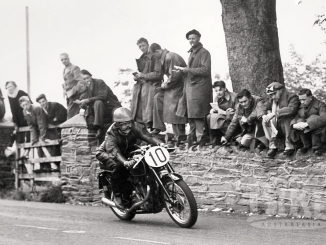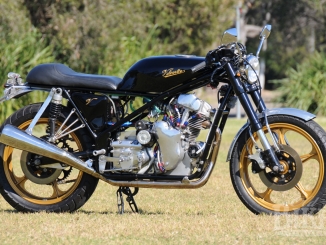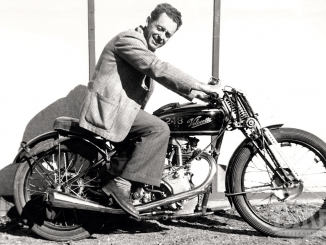
From our Old Bike Archives – Issue 64 – first published in 2017.
Story: Jim Scaysbrook • Photos: Sue Scaysbrook, Dennis Quinlan, John Hiscock, Gil Loe.
For what is essentially a tuned version of the venerable Venom single, few traditional British bangers get the pulse racing like the Velocette Thruxton.
And yet the Thruxton, which is today regarded as the pinnacle of the company’s road-going products (as opposed to the illustrious line of works and customer racers), was not conceived by Velocette themselves, but as a spin-off of the efforts of dealers, primarily L. Stevens (with Reg Orpin as the main man) and Geoff Dodkin. Production Racing, albeit in the British form that allowed many modifications and non-standard equipment, was big business in the late ‘fifties and early ‘sixties, with the Silverstone 1000 Kilometre and Thruxton Nine Hour being the biggest and attracting the lion’s share of publicity.

Reg Orpin had been building racing Velocettes that incorporated his own ideas for some years, even to the point of building a highly developed version that, in the hands of top racer Joe Dunphy, gave a good account of itself at European international races. Dodkin’s Venom, ridden by Ron Grant and Keith Payne, grabbed third place in the 500cc class in the 1961 Thruxton race, and went one better the following year (and finished third outright), ridden by Ellis Boyce and Tom Phillips. 1964 was the year it all came together for Orpin’s Thruxton entry, when Alan Harris and Howard German won the 500 class (with Venoms second and third) and finished third outright.
Although the big twins were by now all the rage, L. Stevens began supplying a range of parts to bring standard Venoms up to something approaching the Production Racing models, at least visually. Included in the optional extras were racing magnetos, full width aluminium hubs (the front available with a John Tickle-produced twin leading shoe brake plate), clip-on handlebars, swept back exhaust pipe, rear set footrests, gear lever and rear brake pedal, and a 1 3/8” Amal GP carburettor. Top of the list was a special cylinder head with larger inlet valve and a reduced valve angle, plus a distance block that sat on extended studs. The big carb extended so far that a revised oil tank, sitting lower and further to the rear, was required, while a cut-out in the right rear of the petrol tank allowed clearance for the top of the downdraught GP. The Orpin-conceived L. Stevens machine was taken to the Velocette factory for their consideration, and in boss Bertie Goodman’s opinion, this machine could well gain a foothold in the market now dominated by the twins.

At the Earls Court Show in November 1964, what was listed as a brand new model, the Velocette Thruxton, was displayed on the company’s stand alongside the Thruxton-winning Venom and the famous Clubman model that had averaged 100 mph for 24 hours at the banked oval Circuit de Vitesse at Montlhery, France in 1961. Velocette claimed a power output of 41 hp for the new engine, which retained the standard Venom cams but with 1 ¼ inch radius followers instead of 1 inch. The new head was sand cast, rather than die cast on the other singles, and remained so for the Thruxton’s entire production run. The crankcases were heat treated to cope with the increased performance. The new Thruxton featured the modified petrol and oil tanks, plus a new battery box which was plucked from the Valiant model, turned 180 degrees. Buyers had the option of standard or ‘TT’ close-ratio gears, the latter having a tall 8.4 first gear that could require a bit of clutch slipping around town.
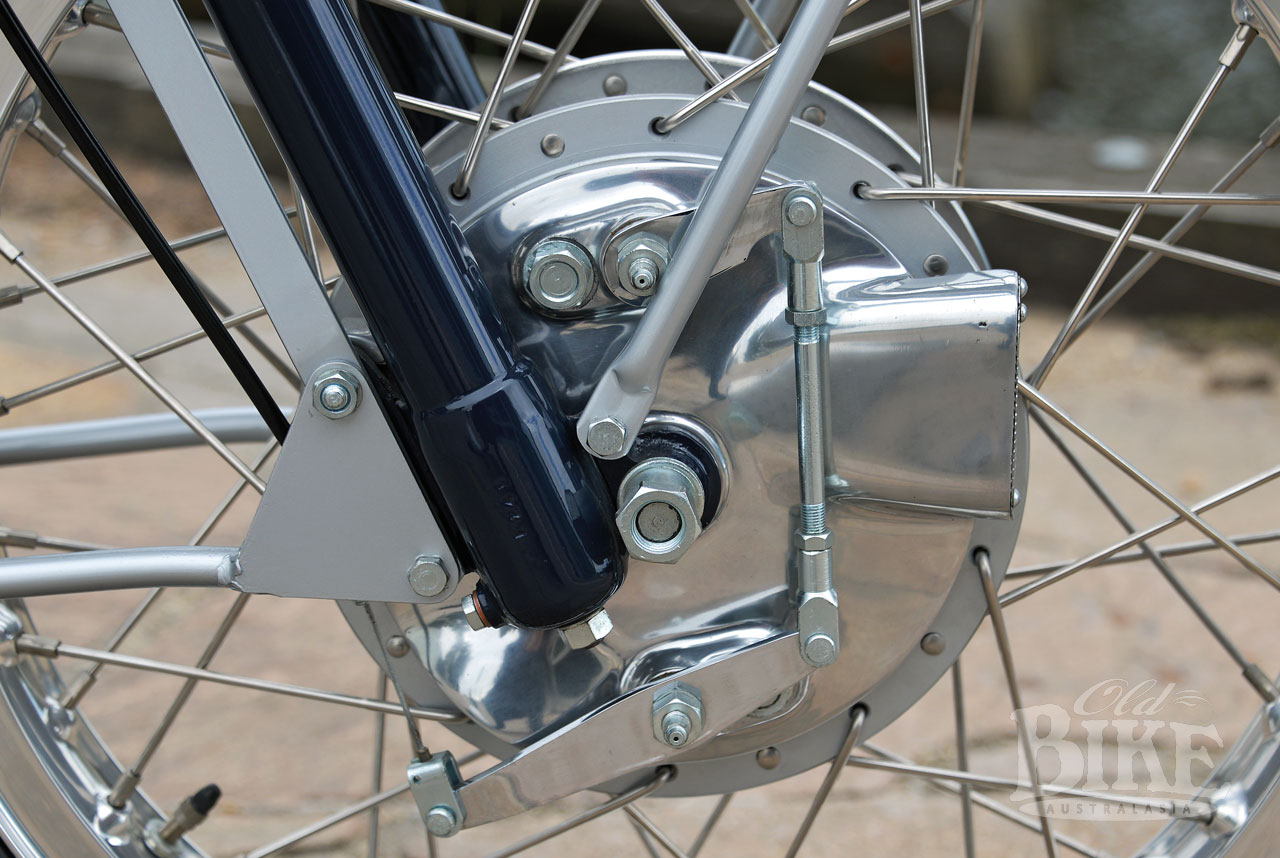
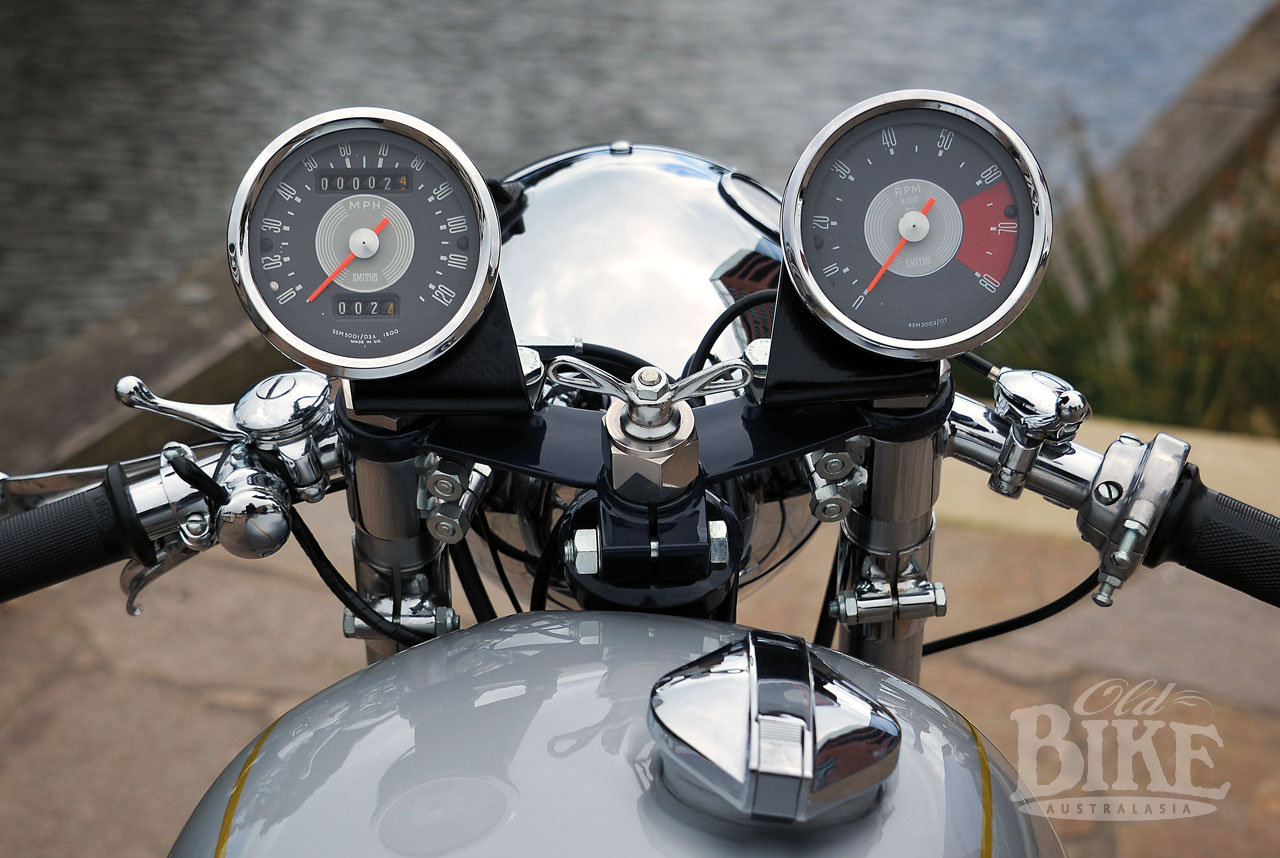
The model was finished in silver with gold striping for the petrol tank and mudguards, with the frame and other items in a tasteful dark blue colour which had in fact been suggested by Reg Orpin, who had even supplied the paint samples. Topping it off was a racing style hump-back dual seat, also in blue. Dunlop alloy rims looked the part, the rear having a wider 3 ½ inch section. Double damped forks and Girling rear units with exposed springs completed the suspension department.
Naturally the Thruxton caused great excitement at the show, but one thing that was not disclosed was the price, and fully six months passed before a figure of £369/19/2 was announced – 46 quid more than the Venom Clubman. When it finally went on sale, the production Thruxton differed from the Earls Court model in several respects, including the use of the normal Velocette Woodhead rear suspension units. As well as the silver/blue décor seen at the Earls Court Show, the Thruxton could also be ordered in the traditional Velocette black with gold striping.
A few Thruxtons appeared with the Tickle front brake, but the majority sported a copy produced for Velocette by T.F. Blumfield, which were easily identified by having a smaller, square-sided air scoop with air exit holes at the rear. Another highly visible option was the Avon Veeline fairing, priced at £25/10/-. These fairings were made in two pieces, and colour matched to the motorcycle in either black or silver/blue. They had a Perspex nose-cone in the fairing with the headlight unit mounted in the fibreglass, and had an amp meter installed in the section above the headlight. Later models used a three piece fairing that dispensed with the Perspex nose, with a conventional steel headlight shell and glass.
Ironically in the new model’s first production year, 1965, the annual Thruxton 500 Mile race was cancelled and transferred to the Castle Combe circuit near Bath, where in a race of attrition, the L. Stevens entry won the 500cc class ridden by Joe Dunphy and journalist David Dixon. Further racing success came in the annual 500 mile race, run in 1966 at Brands Hatch, where Tom Phillips and Dave Croxford took out the 500cc class, and later in the year, Geoff Dodkin’s machine won the 500cc class at the Barcelona 24 Hour Race. Although strapped for cash, Velocette was persuaded by Reg Orpin and Geoff Dodkin to assist in supplying special engines for the newly-instigated Isle of Man Production Machine TT which was incorporated into the program in 1967. The factory produced three engines, two going to Orpin and one to Dodkin, each incorporating a special squish head design with a modified Manx Norton piston, flywheels turned from a solid billet with special mainshafts, and self-aligning main bearings. With experienced Manxman Neil Kelly aboard, the Orpin machine finished a sensational third outright, behind the winning 650cc Triumph Bonneville ridden by John Hartle, and Paul Smart’s 750cc Dunstall Norton. Runner up in the 500cc class was the Dodkin entry, ridden by Keith Heckles. Fitted with the highest possible gearing, Kelly recorded 121 mph through the electronic speed trap at The Highlander.
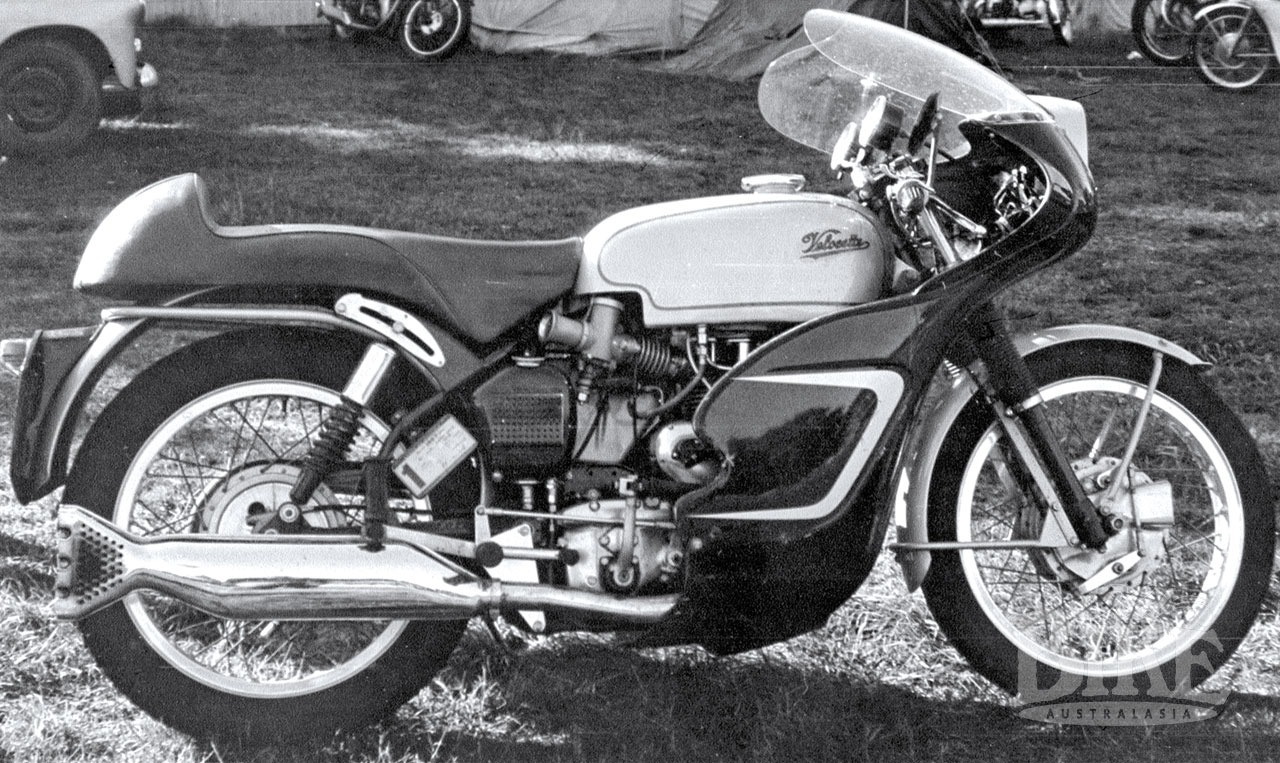
Demand for the Thruxton soared, but it was something of a double-edged sword for the cash-strapped factory, which was experiencing increasing problems with the supply of proprietary parts. Despite the fact that the Thruxton was almost £100 more expensive than a Triumph Tiger 100 and £30 more than a Triumph Bonneville, demand continued at a healthy level, provided the customer was prepared to wait for delivery, sometimes for several months. The model gained a redesigned gear linkage and pedal for 1967, which replaced the previous reversed lever, as well as a completely new rear brake pedal. For 1968, the supply of magnetos had essentially dried up and ignition was switched to battery and coil (which was considerably cheaper), with the letter ‘C’ added to the engine number to denote the coil. But the end was in sight for the Thruxton, and indeed for Velocette itself.
By 1970 the factory was moribund, crippled by the tooling costs for the new Viceroy scooter and other accumulating problems. Ironically, the order book, particularly for the big singles, was still healthy, but according to noted Velocette historian and author Rod Burris, the very last motorcycle to leave the Hall Green factory before it was closed was a Thruxton, with a list price that had risen to £530. In all, 1108 Thruxtons are believed to have been built from 1965-1970.
By the time the last Thruxton rolled out, it was pretty much game over for Velocette out here in the colonies. The traditional importers like Whites (NZ), Borgelt (South Australia), Cottmans (Melbourne) Mortlock (WA) and P&R Williams (NSW) had long gone, and most of the later Thruxtons came into Australia via Frank Mussett in Melbourne and Burling and Simmons in Sydney, with a list price of $1095, plus an extra $100 for the fairing.

In the saddle
According to prolific author and road tester Bruce Main Smith, his pleas (and those of all other journalists) to be allowed to test a Thruxton were repeatedly ignored by the factory. In fact it was not until after the factory had gone into liquidation that he finally got his hands on one. He surmised that Velocette “were never satisfied with their demon tweak of the Venom, and shrank away from putting it out for independent evaluation. The works perhaps believed that if one was released to a widely-experienced road tester, the single would be slated for everything from the glow-worm lights, or a low-geared kickstarter, to an impossible cam for its valve timing.” Strong words, but Main-Smith goes on to say that the factory’s fears were ill-founded and that if the Thruxton had continued in production beyond 1970 (or been recreated by the new owners of the marque, Aerco Jigs and Tools), it would have been “a very marketable bike.” The Thruxton that he finally tested was owned by L. Stevens and prepared by Jack Passant, incorporating a Nimonic 80 exhaust valves with titanium valve caps and pushrod ends. With a megaphone fitted, the machine was dyno tested and produced 45.8 bhp at 6,400 rpm.
Main-Smith was known for having a creative turn of phrase, and he described the starting drill thus. “Starting was easy, but not the start-up prelude. Flood the cold engine by laying the bike on its side, for tickle the (Amal GP) carburettor you cannot. The choke appeared to be redundant to the point that it might even have been disconnected! Then, with the magic Velocette kick-starter drill, she starts. Oh yes, a girl could do it, but it has to be done right – or you sweat, you curse, and you look an idiot.” He was also highly critical of the steering lock with the fairing and clip-on handlebars, which made turning “still to be measured in furlongs, not yards.”

A Kangaroo hop
In March 1966, the annual Kangaroo Rally took place at Burrumbeet Park near Ballarat – a typically well attended show with more than 300 bikes present, ranging from classics like Chris Harley’s 1921 4-cylinder Nimbus and Ralph Datlan’s Brough Superior SS100 “Pendine” to the latest models – two of which were Thruxtons sold by Frank Mussett in Melbourne. One was engine number VMT175, and as the series began at 101, was the 74th produced, and was ridden to the rally by its owner Roger Dracup. The second of the two silver Thruxtons was fitted with the original style fairing with the headlight unit in the nose section. Both would have been built in late 1965, so they were probably among the first Thruxtons sold in Australia. Both were fitted with the Tickle brake plate.
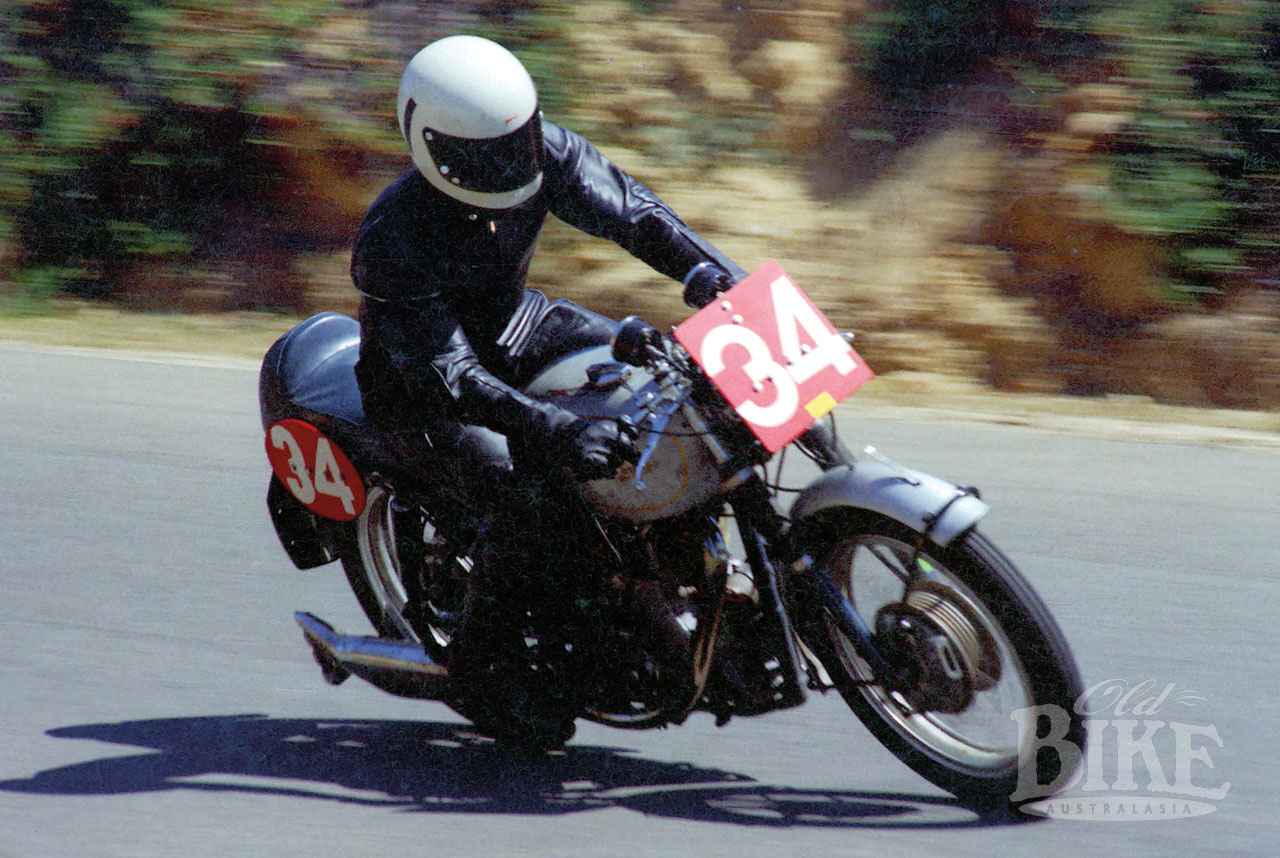
The last hurrah; a Six Hour fling
Dennis Quinlan, doyen of the Australian Velocette scene, decided to enter his Thruxton in the second running of the Castrol Six Hour Race, at Amaroo Park in 1971. He had purchased the bike, which was delivered via Burling & Simmons in Auburn, in February 1967. “I well remember picking up the bike,” says Dennis. “My wife Judy drove me to Auburn and I had to take it to the motor registry to get it inspected before I could ride it home. When I was picking it up, Norm Burling walked up to me and said he wanted an extra $50 for the tacho, to which I replied that it was shown as standard equipment in the brochure. He just shrugged and walked off! I guess he thought he’d just try that one on me.” Nearly five years later, Dennis began to think about entering the Six Hour. “I didn’t think we had any chance of winning the 500cc class, I was just interested in having a Velo in it, says Dennis, fifty years on. “At that stage, the rules didn’t stipulate how old a bike could be, although that later changed so that the race was for current models. Velo had not long closed and I thought it would be nice to reprise some of the long distance races that the Thruxtons had contested.”
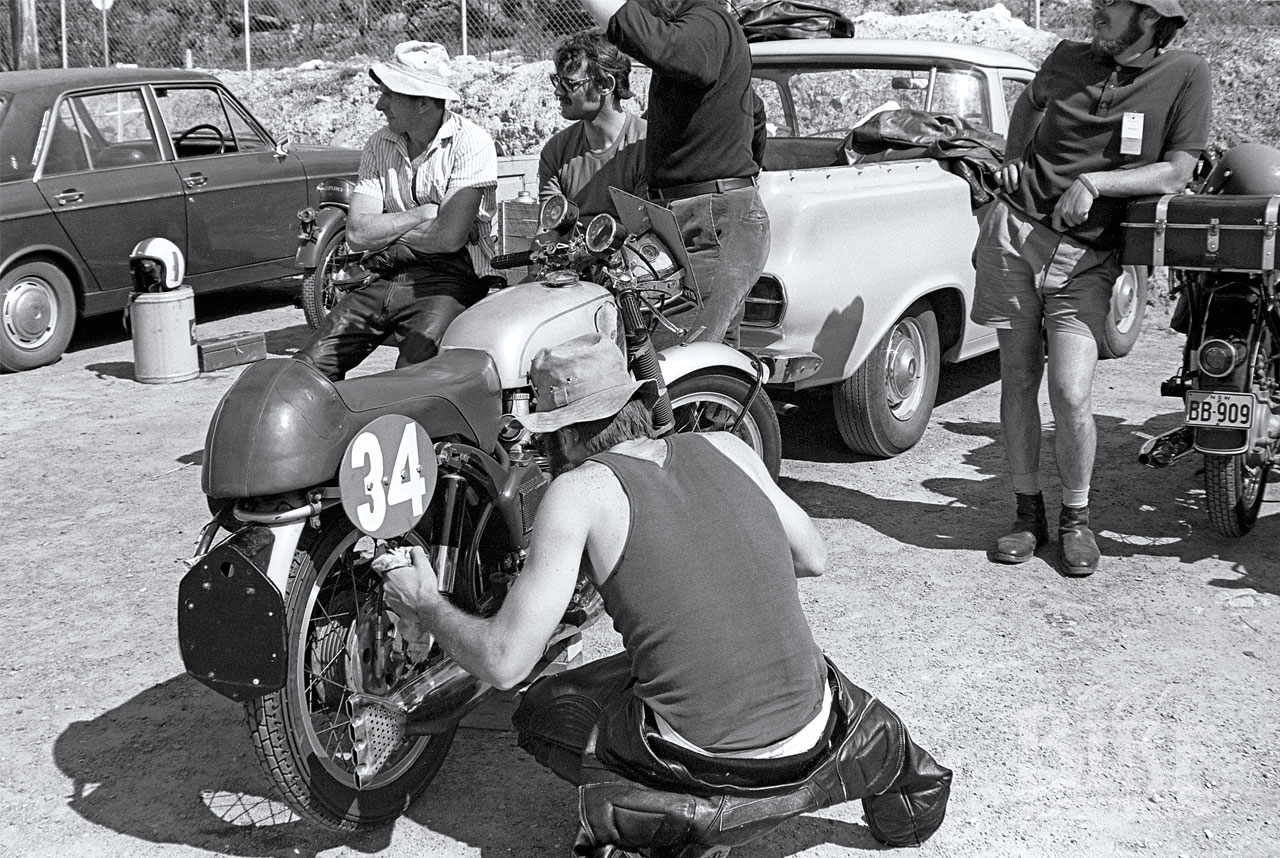
Dennis’ Thruxton had around 30,000 miles on it by late 1971. Race preparation consisted of a set of new Metzeler C5 tyres and a careful tune, but a few glitches appeared in the lead up to the race. “I called up Dennis Fry, who had plenty of international experience on Nortons and Velos, and he said he was interested in joining me in the team. One small problem was that he had a bung right foot from a crash overseas, and couldn’t change gear properly. So I rang up the race secretary Vince Tesoriero and asked if we could fit a rocking pedal. I think he reckoned we were not going to figure in the results, so he said yes. We need a third rider as reserve so I enlisted John Herrick, who lived near me. A few weeks out from the race John and I took the bike to Amaroo Park, and we found it was valve bouncing at 6,200 rpm with the original hairpin valve springs. Then John missed a gear and bent the exhaust valve, which meant I had to get a new Nimonic valve from L. Stevens in London. I fitted coil springs to the head (which would allow us to rev it to 7,000 before valve bounce) rather than put the original hairpin springs back in, and just decided to take the risk of being disqualified if we finished in a place. We also found that the inner baffle in the muffler had rusted out and got jammed over the exhaust pipe, which meant it wouldn’t rev at all, so we just put a pair of long nose pliers down the pipe and pulled it out. The other bit of cheating we did was that I had been using a 115/145 octane petrol from ESSO, which was purple, whereas the ‘legal’ super grade was a straw colour. I was working for the CSIRO at the time and got hold of some A20 dye that was used for histology in the laboratory, so we dyed twenty gallons of purple stuff to straw colour! I used Shell Aero single grade oil which I had used in BMWs with no problems. Searching for every fraction of a horsepower, we even cut the generator drive belt and left it inside the cases so it would appear that it had snapped.”
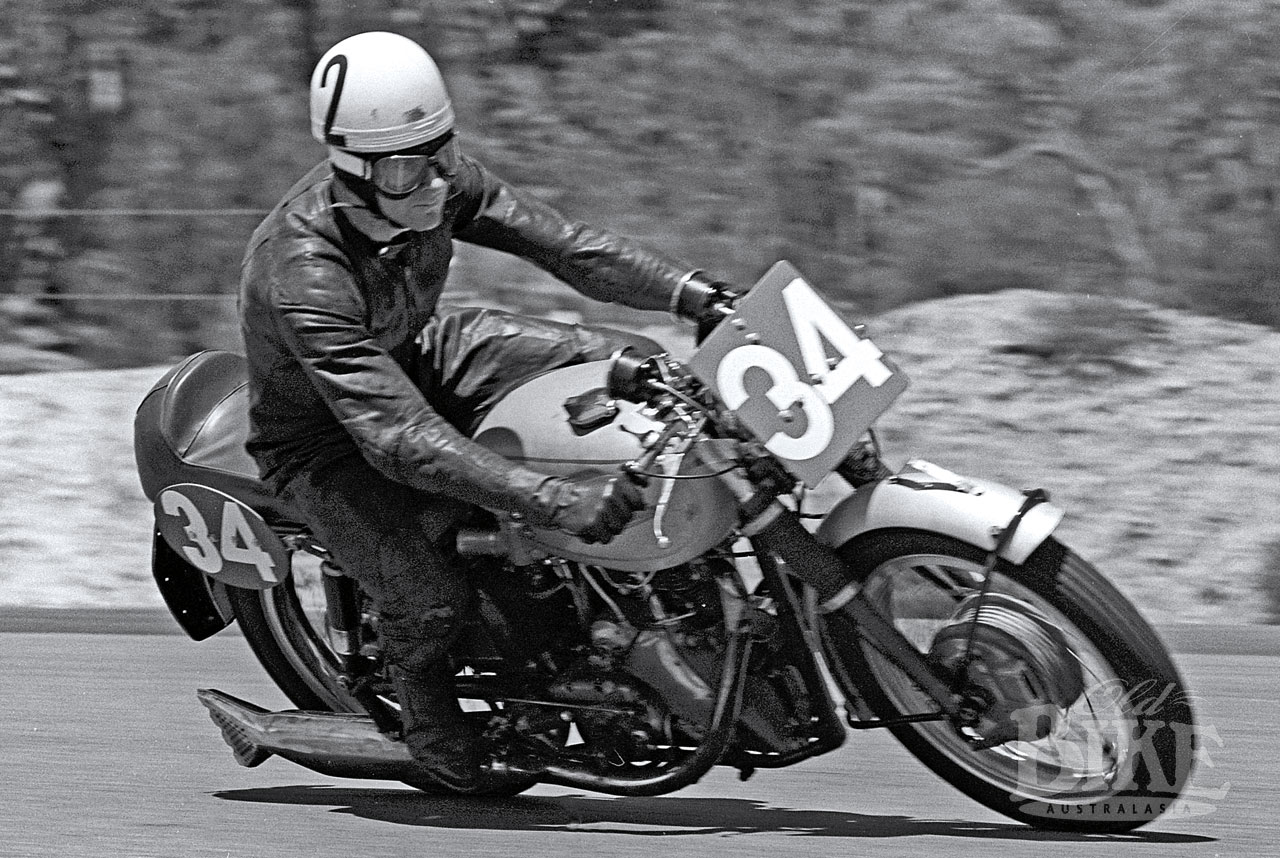
There were 26 entries in the 500cc class – more than for the Unlimited or 250cc classes – mainly two strokes from Yamaha, Kawasaki and Suzuki, plus three Honda CB500s, one CB450, two Ducati 450 Desmos, plus one Velocette. The Velo team knew they could get two hours from a tankful of fuel, which meant only two stops instead of four for the majority of the field. In view of Fry’s bad foot, Quinlan took Le Mans start and the first stint in the race, handing over to Fry while running mid-field. “At the start, I had to kick start the bike but there was so much noise around from all the electric start bikes the only way I could tell that it was running was from the tacho! As soon as Dennis Fry went out he began lapping one to one-and-a-half seconds a lap quicker than I had been, so I took the decision to let him do consecutive two hour stints, which meant that John Herrick wouldn’t get a ride. So John and Jim Day just acted as pit crew. I think we had done 127 laps when the bike failed to appear. We soon found out that Dennis had grounded the silencer through Dunlop Loop and slid into the earth bank. The bike went up into the air and landed on the rear wheel, which collapsed, and also squashed the silencer. Then it went over again and broke the bottom off one of the fork sliders and bent the frame, so that was the end for us. Dennis Fry suffered concussion and went to hospital by ambulance.”
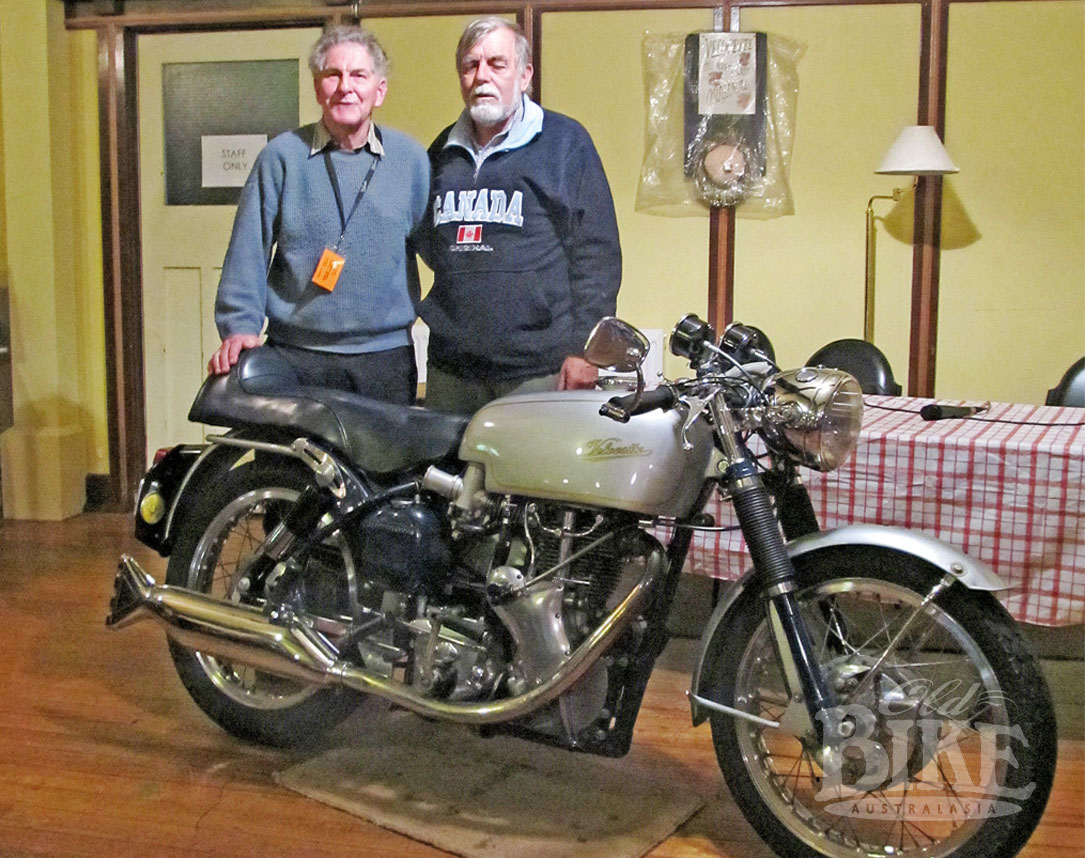
The Thruxton went home a sorry mess, and laid around for some years in a dismantled state, during which time Fry straightened the frame and other repairs were made. “I had occasional offers to buy it, but nothing came off until 1980 when Tony Keen bought it, still in bits, and eventually put it back together. I had paid Burlings $990.00 originally, and Tony paid me $2,000, He later sold it to Steve Hazelton, who on-sold it to Western Australia, where it still lives. The owner actually bought it over to the Velo Rally at Bundanoon (NSW Southern Highlands) in 2012, where I was able to sit on it again. Interestingly, my engine number was VMT 458, and it came in a crate with another Thruxton, VMT 457, which is still owned by John Jennings. When they had the Castrol Six Hour celebration at the Broadford Bonanza in 2014, John did his bike up to look like mine and rode it at the meeting.”
And so ended the sometimes glorious Production racing history of the Velocette Thruxton, at least in Australia. Both L. Stevens and Geoff Dodkin continued to enter British and European events for a few years, but the glory days of the big single had passed.

A local lovely
Our featured Thruxton belongs to Jon Munn and is always proudly on display at his business, Classic Style Australia at Seaford Victoria. John purchased the Thruxton from a deceased estate in USA, along with an MSS. It turned out that the MSS had quite a story of its own, being the very last example of the model to come out of Hall Green before the doors shut forever. The Thruxton is engine number VMT 125, the 25th one built in 1967. Being an early model in the series, it sports the John Tickle front brake rather than the later Blumfield/Velo version, and also has the elliptical headlight shell rather than the later fully circular version used on most Thruxtons and Sportsmans. Thanks Jon for allowing us to photograph a very handsome and beautifully presented motorcycle.
Specifications: Velocette Thruxton. (1965-1970)
Engine: Overhead valve air-cooled four stroke single. Built-up flywheel assembly supported on tapered roller main bearings with caged big end and plain small end.
Bore x stroke: 86mm x 86mm
Capacity: 499cc
Compression ratio: 10.8:1
Carburettor: Amal GP2 1 3/8” bore with remote fuel bowl.
Transmission: 4-speed gearbox with single-row primary chain.
Frame: Round section steel tube with brazed lugs.
Suspension: Velocette telescopic forks with 2-way hydraulic damping. Swinging arm rear with Woodhead single-rate dampers, adjustable for spring tension in cantilever top slots.
Electrics: Lucas 60 watt 6 volt dynamo with belt drive, automatic voltage control, 36/36 watt headlamp, 13 a.h. battery.
Ignition: Lucas racing magneto
Wheelbase: 54 inches
Weight: With 1 gallon of fuel, oil and tools 402lb.
Equipment: Ammeter, 125 mph Smith speedometer, 8,000 rpm Smiths tachometer. Tool kit.
Options: Mitchenall Bros Avon Veeline fairing, 4 ½ gallon fuel tank.


